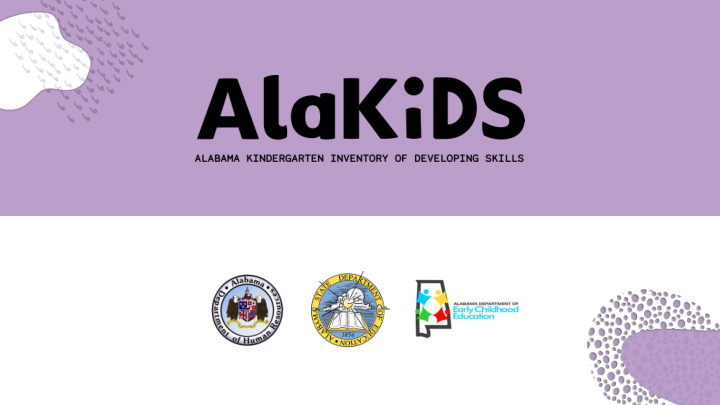



The full extent of achievement gaps are present when children enter kindergarten. Schools do not significantly increase gaps; in fact they may reduce them somewhat- only to see the gaps Why a widen again each summer. Kindergarten Entry Children often come to Kindergarten up to two years behind. Research shows that even the best teacher and instruction only is able to close that gap by 1 to 1 ½ years only Assessment? to have the summer slide widen the gap once again. Due to COVID19, Alabama’s early learning programs, childcares and livelihoods of families have been disrupted. This disruption has put many of Alabama’s children at risk of entering kindergarten behind the widely held expectation of a typically developing five-year-old.
Whole Child Assessment Whole child assessments allow teachers to begin immediately meeting the individual developmental learning needs of each child by informing instructional practices and program development. Assessing the whole child is inclusive of Executive function skills not in isolation from academic learning. Executive functioning skills are mediate prediction of higher literacy scores in third grade. -Sasser, Bierman, & Heinrichs, 2015; Cavanugh et al, 2016
It is currently being aligned to the state's newly revised Alabama Standards for Early Learning and Development (ASELD). The revision of the standards was accomplished in collaboration with DHR, Head Start, ADECE, Higher Ed, and Early Childhood professionals in Alabama. AlaKIDS is a whole child assessment that will provide the Kindergarten teacher with needed AlaKIDS is fully aligned to the Alabama Course of Study for Kindergarten: English Language Arts (2016) and Mathematics information on a child's independent skills and (2015). abilities.
How is AlaKIDS Different from previous KEA? KEA 2017 AlaKIDS 2020 ADECE Lead Agency Collaboration between DHR, ALSDE, and ADECE 51 objectives 34 objectives Observation based Hybrid with standardized prompts and materials Finished in October Completed in first 3 to 4 weeks of school IRR Required IRR is not required to do the survey Weekly guide and subs provided to enter Guide for daily small group and individual child Kindergarten documentation weekly Entry Assessment *Teachers could continue to use the tool to form daily instruction beyond *Teachers can continue to use tool to form daily instruction beyond first first checkpoint checkpoint
List of Whole Child Objectives for AlaKIDS Comprehensive Objectives for Development and Learning Social-Emotional Physical Language 4. Demonstrates traveling skills 8. Uses languages to express thoughts and needs 1. Regulates own emotions and behaviors a. Uses an expanding expressive vocabulary a. Takes care of own needs appropriately 5. Demonstrates balancing skills b. Uses conventional grammar c. Tells about another time or place 2. Establishes and sustains positive relationships 6. Demonstrates gross-motor manipulative skills b. Responds to emotional cues 9. Uses appropriate conversational and other c. Interacts with peers 7. Demonstrates fine-motor strength and coordination communication skills a. Uses fingers and hands d. Engages in conversations 3. Participants cooperatively and constructively in group situations b. Uses writing and drawing tools d. Balances needs and right of self and others e. Solves social problems Cognitive Literacy Mathematics 12. Demonstrates phonological awareness 10. Demonstrates positive approaches to learning 17. Uses number concepts and operations a. Notices and discriminates alliteration a. Persists a. Counts b. Notices and discriminates smaller and smaller b. Solves problems b. Quantities units of sound c. Shows flexibility and inventiveness in thinking c. Connects numerals with their quantities 13. Demonstrates knowledge of the alphabet 11. Remembers and connects experiences 18. Explores and describes spatial relationships and shapes a. Identifies and names letters a. Understands spatial relationships d. Makes connections b. Uses letter-sound knowledge b. Understands shapes 14. Demonstrates knowledge of print and its uses 19. Demonstrates knowledge of patterns a. Uses and appreciates books b. Uses print concepts 15. Comprehends and responds to books and other texts a. Interacts during read-aloud and book conversations b. Uses emergent reading skills c. Retells stories 16. Demonstrates emergent writing skills a. Writes name
June/July Kits will be assembled and delivered to kindergarten teachers. June Trainings for the Trainers- Establish a cohort of certified trainers (Regional Implementation Coaches from ADECE and ALSDE) throughout the state to partner in providing introduction to AlaKIDS training and support implementation after year one. Timeline 2020 July 6 Hour Training for Teachers August/September AlaKIDS will be administered to all kindergarten children within the first 3 to 4 weeks of the start of school.
Reporting 1 Information collected through the tool provides data to inform planning and individualizing instruction for each child, as well as helps share information with family members and other key stakeholders. Administrators can attend a virtual training on ways to support teachers’ use of 2 the assessment tool and gain understanding of embedded reports to inform instructional practices.
Recommend
More recommend